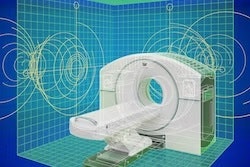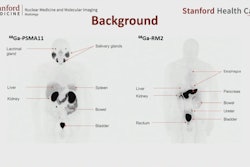F-18 FDG-PET/MRI scans without the use of a contrast agent should be the top choice for imaging children suffering from lymphoma, according to research presented at RSNA 2023 in Chicago.
In a scientific session held on 30 November, Dr. Nils-Martin Bruckmann discussed a study that evaluated FDG-PET/MRI scans with and without the use of a contrast agent in children with newly diagnosed disease. The study authors found the contrast agent made no diagnostic difference.
“The use of MRI contrast agents in F-18 FDG-PET/MRI examinations has no additional positive benefit for primary and follow-up staging of pediatric lymphoma patients,” he said.
 Dusseldorf University Hospital. Photo courtesy of Olaf Doering/Alamy Stock Photo.
Dusseldorf University Hospital. Photo courtesy of Olaf Doering/Alamy Stock Photo.
Lymphomas represent approximately 15% of all tumor diseases in children and imaging plays a key role in tumor staging to plan treatments. While contrast agents used in F-18 FDG-PET/MRI scans can help improve the quality of imaging, they are associated with adverse events, such as allergic reactions, and these reactions are especially concerning in sensitive pediatric patients, Bruckmann noted.
To provide evidence on whether the use of these agents is necessary in children, the researchers enrolled a cohort of 32 pediatric patients between the ages of 7 and 20 who underwent 105 scans with and without contrast agents. Lymphoma was present in 65 of the 105 (62 %) examinations.
Patients underwent either F-18 FDG-PET/MRI scans comprising unenhanced T2-weighted and/or T1-weighted and diffusion-weighted imaging (PET/MRI-1) or PET/MRI scans comprising an additional contrast-enhanced T1w sequence (PET/MRI-2). All datasets were analyzed by two expert readers on a patient-based and region-based level, with follow-up and prior examinations as well as histopathology serving as the reference standard.
According to the findings, PET/MRI-1 and PET/MRI-2 both determined the correct tumor stage for 90 out of 105 tumors (86%). And based on a region-based analysis, both also correctly identified 119 out of 127 (94 %) lymphoma-affected regions.
In addition, the sensitivity, specificity, positive predictive value, negative predictive value, and diagnostic accuracy for PET/MRI-1 and PET/MRI-2 were the same.
“There were no statistically significant differences between PET/MRI-1 and PET/MRI-2 reading protocol,” Bruckmann said.
Ultimately, F-18 FDG-PET/MRI is increasingly accepted for staging of lymphoma patients and the present study further confirms the feasibility and high diagnostic accuracy of it in pediatric lymphoma patients, Bruckmann said.
“The switch to a contrast agent free F-18 FDG-PET/MRI protocol should additionally be discussed in all pediatric lymphoma patients,” he concluded.




















